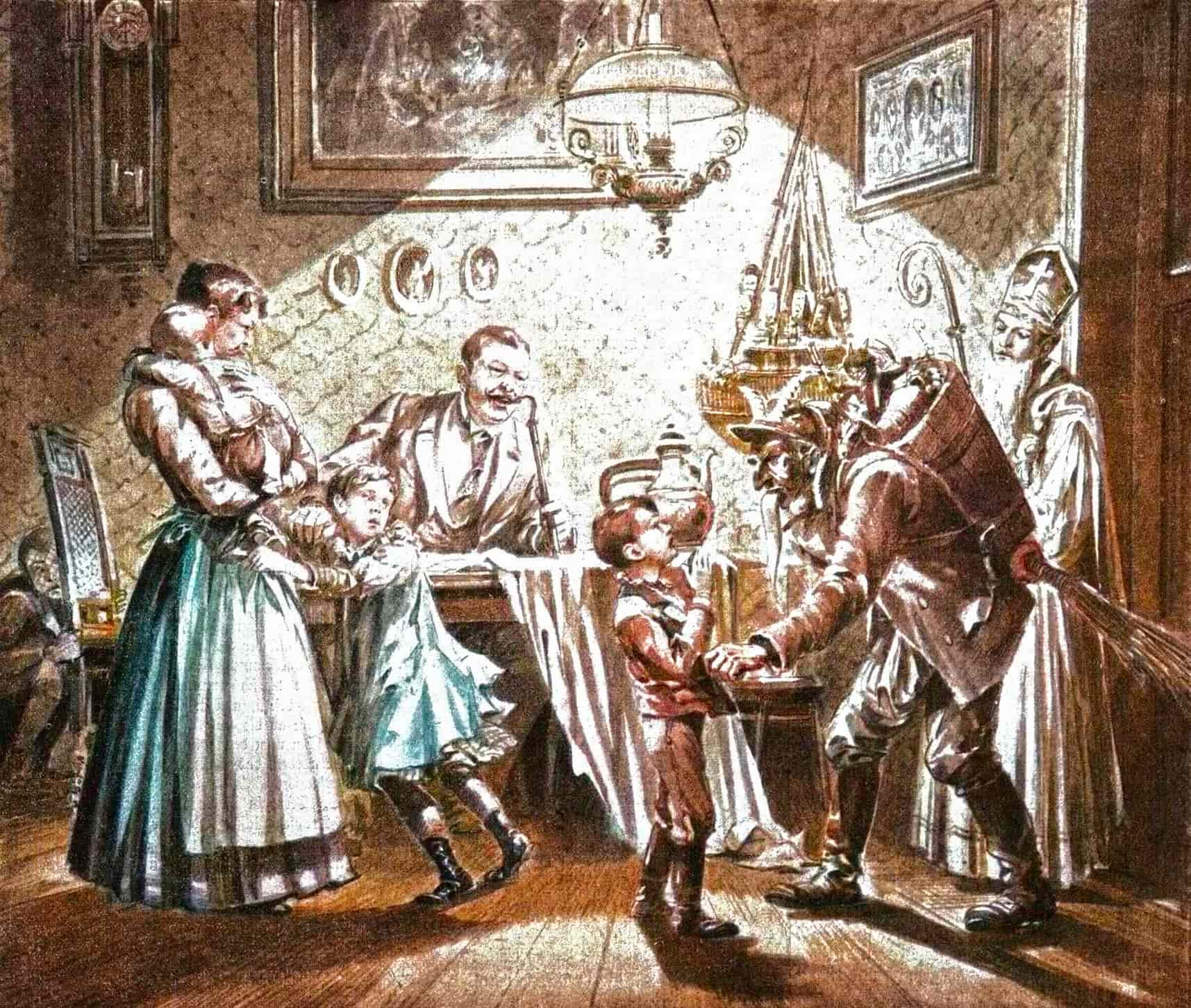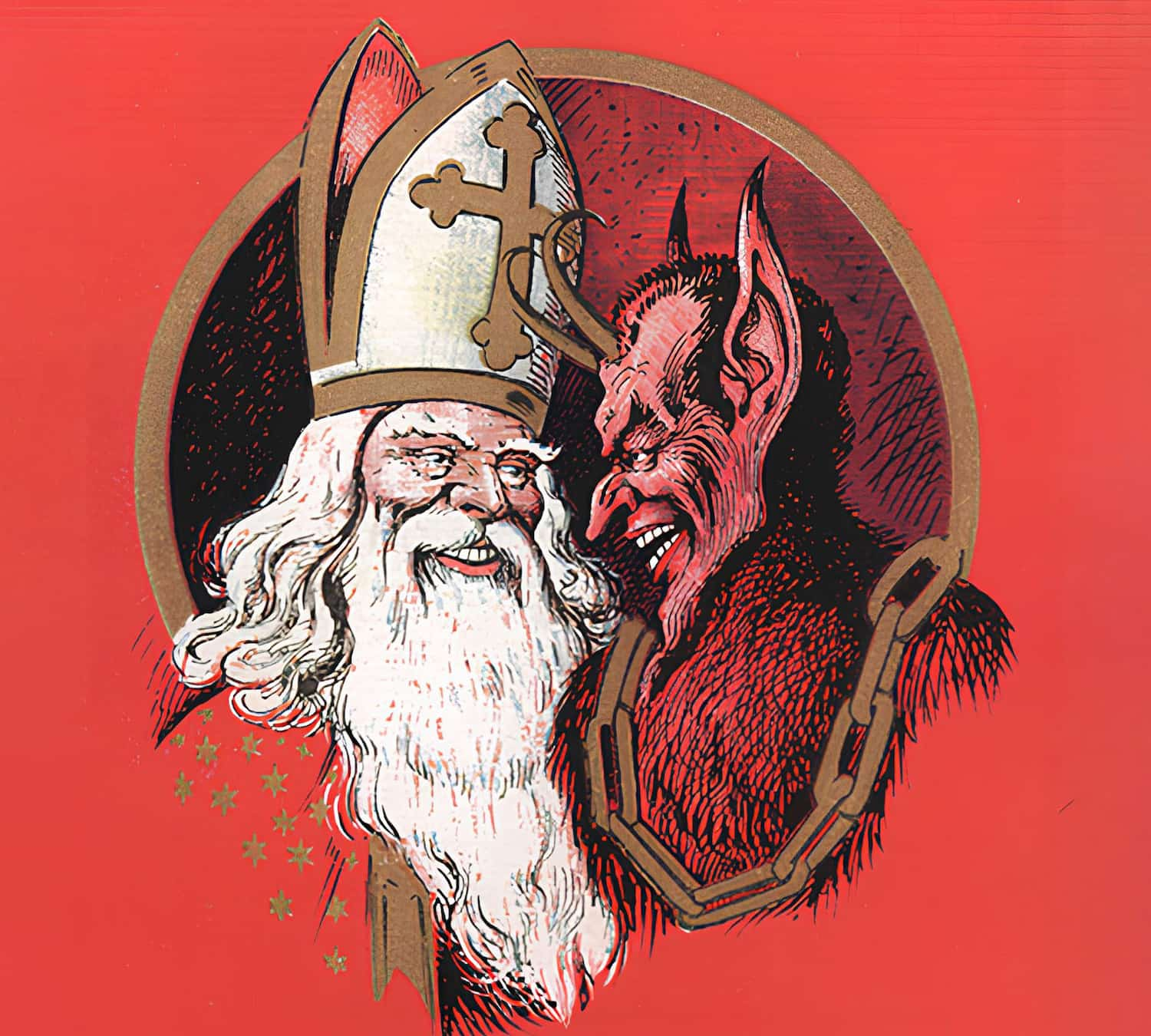The Krampus is a frightening figure in the Advent tradition accompanying Saint Nicholas. He is widespread in the Eastern Alpine region, southern Bavaria and the Upper Palatinate, Austria, Liechtenstein, Hungary, Croatia, Slovenia, Slovakia, the Czech Republic, South Tyrol, Trentino, and parts of non-Alpine Northern Italy. While Saint Nicholas rewards well-behaved children with gifts, the naughty ones are punished by Krampus. The figure of Krampus originates, like many other demonic figures in the Alpine region, from pre-Christian times. The group consisting of Saint Nicholas, Krampus, and other companions is referred to in Bavarian dialects as Bass or Pass.
History of Krampus
Origin of the Name

The name is derived from the Middle High German “Krampen,” meaning ‘claw,’ or Bavarian “Krampn,” referring to ‘something lifeless, dried up, withered, or wilted.’ In many regions, the figure of Krampus has merged with the Perchta (or Berchta) tradition (an Alpine pagan goddess).
In the Bavarian Alpine foothills and the Austrian Salzkammergut, Styria, and Salzburg, Krampus is more commonly known as Kramperl.
In Styria and Carinthia, the term Bartl is also used, a short form of Bartholomew. Due to the centuries-long Slovenian-German bilingualism in Carinthia and Styria, it can be assumed that the Slovenian term “parkelj” also derives from “Bartl,” especially since the shift of t → k and d → g (Kittel → kikelj, Kandl → kangla) occurs in other Slovenian loanwords. In the Salzkammergut, the term Miglo is also used. In the Tyrolean region, one often speaks of Tuifl, Tuifltåg, or Tuifltratzen, derived from the word Devil. The term Ganggerl is also used.
The Krampus tradition was originally widespread throughout the Habsburg Empire and adjacent areas and was later banned during the Inquisition, as no one was allowed, under the penalty of death, to disguise themselves as a devilish figure. However, this winter custom continued in some remote places.
Origins and Development of the Krampus Tradition
There are no sources before the end of the 16th century. The custom seems to have developed only since the mid-17th century, starting in monastery schools (Children’s Bishop Feast): Accompanied by frightening figures, devils, and animal masks (Habergeiß), Saint Nicholas checks and rewards well-behaved children, while the naughty ones are punished by Krampus. In the Counter-Reformation era, parlor games emerged, which still exist in Bad Mitterndorf, Tauplitz, and Pichl-Kainisch (Salzkammergut), in Salzburg, and in Tyrol.
Since that time, Krampus groups have formed in parallel with the Perchtenlauf. In the Perchtenlauf, only able-bodied, unmarried men from the village were allowed to participate, and the event became public again in the mid-19th century. Outside the areas influenced by the Counter-Reformation, Krampuses remained displaced by the North German-Protestant figure Knecht Ruprecht. In the Alemannic-Protestant region, the two forms mix, likely sharing a common origin in an Italian figure from the 16th century: there was the idea that the devil would devour the souls of sinners. Evil is particularly strong in the harsh winter season, hence manifesting in this form, which was vividly depicted.
Krampus Runs
In many villages and cities in the Eastern Alpine region, southern Bavaria and the Upper Palatinate, Austria, parts of the Principality of Liechtenstein, Hungary, Slovenia, Slovakia, the Czech Republic, Italy (limited to South Tyrol, Trentino, especially in the Vinschgau and Pustertal), and parts of Croatia, there are still Krampus parades. People dressed as Krampus march through the streets, making loud noises with their bells to scare passersby. They also use their long switches. Tuifltratzen (Tyrol) or Kramperltratzn (Bavarian “tratzen” means ‘to tease, mock, quarrel, banter, ridicule’; in parts of Austria: Kramperlstauben, German “stauben” means ‘to scatter, drive away’) is a challenge for the children of the region who try to provoke the Krampuses without getting caught or struck.
Krampus Day is on December 5th, the eve of the Feast of Saint Nicholas on December 6th. Typically, both figures appear together on the evening of December 5th, but in some places, they may also appear on December 6th. Among the largest parades with over a thousand Krampuses (in 2008) is the Krampuslauf in St. Johann im Pongau, held annually on December 6th, and the largest Krampuslauf in Austria in Klagenfurt. The latter covers a distance of 1.5 kilometers.
Variations and Regional Specifics
It should be noted that there are regional differences in traditions that can vary significantly (for example, processions in Carinthia with fireworks, torches, and fire breathers, as opposed to the use of switches to tease onlookers in Salzburg). One of the most impressive and spectacular Krampus parades occurs in East Tyrol. In this region, the tradition includes not only the procession but also a traditional Krampus throw, similar to the throwing technique from “Ranggeln,” between Krampus and a “Raufbold” (brawler). However, this is entirely voluntary for the brave, as designated zones are set up for this type of tradition. The audience can safely observe the spectacle behind barriers.
An additional peculiarity of the tradition is the decades-long practice of “Tischziehen” (table pulling) in the Osttirol dialects, known as “tischziagn” or “tischzoichn.” In these events, organized separately from the parades, some voluntary men sit behind a large, solid wooden table and try to hold the table against the oncoming Krampuses for as long as possible, using their own strength. The goal of the Krampuses is either to tip the table over or to pull it far enough away from the starting point.
This type of competition is decided separately for each round since men usually switch after a round, and the Krampuses divide into different groups.
In the Osttirol Defereggental, on December 5th, Nikolaus and Krampus are accompanied by a series of other figures that have visited the farms throughout the year: Bajazzo, Lotter, and Litterin (beggars), a bridal couple with a minstrel, a doctor, a policeman, a mayor, a firefighter, and Death, symbolizing the transience of life. In Berchtesgadener Land, the southern part of the district of the same name, there are two types of Krampuses: the fully fur-clad “Kramperl” and the more agile “Gankerl” (also: Ganggerl), equipped with stocking trousers without fur and smaller bells. The Gankerl, in turn, accompanies the Bassen, who are entirely bundled in straw, protecting them, and are related to the Glöckler of the Perchten.
In the Gastein Valley, annually on December 5th and 6th, 80 to over 100 groups are active. The various groups, consisting of Krampus, “Engerl” (angels), “Buttnmandl” (tub carriers; not to be confused with the Buttnmandl in Berchtesgadener Land, see paragraph above), and Nikolaus, are recognized by the different colors of their garments. They traditionally go from house to house on December 5th in the centers of the towns Bad Gastein, Bad Hofgastein, and Dorfgastein, and on December 6th in rural areas. The groups visit homes and request entry from the homeowners.
The Nikolaus (and possibly the angel) and the tub carrier enter the room, the “well-behaved” are rewarded, and then the Krampuses or Kramperl are allowed in, and the “misbehaved” are punished. When two groups meet (which can happen frequently, as each group has an independent path from all others), a strenuous and spectacular greeting ritual takes place.
The Nicholases cross their bishop’s staffs, the angels and the tub carriers also greet each other, then come the “Vorteufelrempeln” (the two Vorteufel greet each other and demonstrate their strength through mutual bumping), after which the remaining Krampuses may also bump. Once this is done, the groups recognize each other and wish each other “A guads Weitageh’, treu in guadn oidn Brauch” (a good continuation, true to the good, old tradition). Numerous locals and guests from near and far gather in the Gastein Valley on these two days every year.
In the Alemannic Alpine region (Allgäu, Switzerland), a similar custom is known as Klausentreiben, but with different characters.
The Krampus also shares a function with the figure known as Knecht Ruprecht in the northern and western German regions, but there are differences between the two characters. While Knecht Ruprecht appears individually, the Krampuses usually appear in larger groups.
In Swabia, Pelznickel accompanies the gift-bringer. In Switzerland, Nikolaus is accompanied by “Schmutzli.” Similar to Krampus, Schmutzli is intended to punish naughty children but carries a sack and wears a bell strap instead of cow or beam bells.
The Krampus, in appearance, resembles the devil as well as mythical and animal figures, similar to the Schiechperchten found in Alpine traditions. Unlike the latter, who appear during the Rauhnächte, the Krampuses are exclusively part of Advent traditions.
In the Scandinavian region, similar figures appear between Christmas and New Year’s Eve. This custom is known as “julebukklaufen” and was common in Norway at least until the mid-20th century.
Equipment
- Coat or trousers made of sheep or goat fur. In some parts of Lower Bavaria, it is customary for the “devil” to dress in potato sacks. In this region, there are also fur Krampuses who wear no mask but only fur and horns. In 1928, a furrier’s textbook mentioned Krampus production as a significant use for black rabbit fur remnants.
- Wooden mask (Larve) carved from pine or lime wood, with (real) goat, ibex, or ram horns. Nowadays, there are also many Krampuses wearing aluminum, plastic, or rubber masks.
- Cowbells or beam bells (or “rolls”), attached to a belt or strap on the back. Either a beam bell reaching down to the knees or several smaller to medium-sized cowbells are used. Rattles or bells, on the other hand, are only used by Schirchperchten. Sometimes, a chain for rattling can be found.
- Horsehair or cowtail
- Birch rod
- Butte (Bavarian, also “Kraxn”), a container attached to the back, in which, according to legend, naughty children are taken.
However, the equipment varies from place to place. Typically, Krampus masks cover the entire head. A recent trend includes wooden masks that leave the chin and lower lip exposed, allowing the runner to move the mouth and stick out the tongue. The visible facial parts are painted with appropriate colors to make the masks look more “real.”
Reception
Criticism
Krampus attacks and fights regularly cause dismay and public discussion. Every year, confrontations occur during Krampus runs. Occasionally, spectators retaliate with whip strikes and attack Krampuses. In 2013, after several Krampus runs in East Tyrol, a total of eight injured individuals (mostly with bone fractures) were admitted to the District Hospital Lienz, and over 60 additional patients were treated on an outpatient basis. In 2022, in Upper Austria, an eleven-year-old Krampus performer was grabbed so violently by the horns of his mask and pulled back and forth that he had to be taken to Linz University Hospital.
In the Mirror of Art (Postcards)
Especially at the beginning of the 20th century, artists also embraced the Kramperl as a motif in their artwork.
In Television Series
- Episode 8 of Season 10 of the animated series American Dad dedicated an entire episode to Krampus. He also made a guest appearance in Episode 7 of Season 13 of the same animated series.
- In Season 3, Episode 8 of the series Grimm, the Krampus appeared as a malicious being.
- The Sky series production “Der Pass” and the US horror-comedy “Krampus” delved into the Krampus myth.
Cinema
- Krampus is the main character in the eponymous horror film (2015) by Michael Dougherty.
As a Literary Figure
- BROM: Krampus (original: Krampus – The Yule Lord). Translated from American into German by Jakob Schmidt. Knaur, Munich 2013. ISBN 978-3-426-65334-0.
Music
- The Italian Gothic rock band Lacuna Coil wrote the song “Naughty Christmas” about the Krampus figure.
- The German band Feuerschwanz released the music video “Krampus” in 2021.






